
Stage 8 Locking Fasteners

Sealing of the exhaust manifold is probably one of the most over looked item on an engine. People machine the cylinder head and the block flat for a good seal, but not many people worry about the flatness of the exhaust manifold to seal in the exhaust gas. Even less people worry about the tighteness of the nuts on the exhaust manifold. After all, the gas is going out anyway. Why would it matter if it leaked out earlier in the system. After 110k on the 22RE engine, during an "engine refresh" one of one of the exhaust nut on the lower right hand corner of the manifold was completely loose. The triggered a chain of events. The exhaust manifold made a little mysterious whistling sound while idling. Because of the uneven clamping pressure, the manifold began to warp and leak. Leaking exhaust sucked in fresh air past the gasket, and mixed with the exhaust stream in between pulses. Fresh air diluted the exhaust gas, and changed the reading for the O2 sensor. This caused the fuel mixture to be off. After removing the manifold, I found it was warped by about 1/8". That had to be machine flat again. The problem was that the OEM lock nut does not do a perfect job iin preventing loosening. A new OEM lock nut should always be used when removing the exhaust manifold. However, even with an new OEM lock nuts, sometimes they come loose like in my case. This could be due to wear in the exhaust stud which cause the deformed thread lock nut not to grip the stud as tightly, or parts tolerance or just the sever vibration environment.
The question is why do fasteners loosen anyway. Fasterner loosen due to sliding movement in the bolted joint. The sliding movement cause the fastener to rotate. It takes much more force to tighten bolts than to loosen bolts; therefore, bolts tend to lossen with vibration, and not get tighter. There is a test called the Junker test that tests the loosening of bolts. The fixture is basically two plates that are bolted together with a test bolt. The plates are then subject to vibration. The plates which are supported on bearing slide past each other during the vibration test. The locking properties of the fastener is determined by how long it takes for the bolt to get loose. Tests has shown that split washer does not prevent loosening of bolts. Nylon insert and locking nuts does a better job. However, nylon cannot take the exhaust temperature, and locking fasteners do eventually fail. See Bolt Science for technical information on fasteners.
Given the severe environment in the exhaust manifold which has to carry the mass of the manifold and the exhaust pipe, one of the most permanent soultion is the reusable Stage 8 locking fasteners. The way it works is that a locking tab engages the flats of the nut with the 12 point teeth. The extention part of the locking tab rests on a nearby feature, and prevent the nut from rotating loose. With the locking tab, it is physically impossible for the nut to loosen. The locking action is way more powerful than any locking nuts.

The Stage 8 fastener nut has a groove in the middle of it. A C-clip snaps into the groove, and prevent the locking tab from coming off the nut. Note that the groove is not exactly centered on the nut. The thinner of the two distances from the groove to the face of the nut is about the thickness of the locking tab. The locking tab can then fit snug between the C-clip and the surface of the exhaust manifold flange. In practice sometimes is better to have the wider side next to the manifold so the locking tab is loose. This is because the surface of the exhaust manifold is not very smooth, and installing the locking tab on the wider side make it easier to install the C-clip without subject the C-clip to a constant axial force.

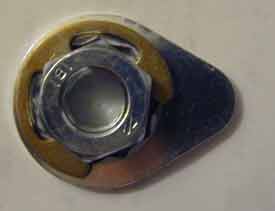
Stage 8 does not make a kit specific for the 22RE engine, but the one that could be made to work is the #4929 10M-1.25 Header Nuts kit + 1 extra 10M nut & 2X M10-1.25 X 15mm bolt. The #4929 cost $33.05 including shipping. The kit includes only 10 header nuts, but Stage 8 threw in an extra one for me for free. The 11 nuts will cover the manifold and the3 nuts on downpipe which is just as likely to come loose and cause problem as the cylinder head side. While not absolutely necessary, 2 M10-1.25 X 15mm lg. bolt can be used for the air injection block plate for engines that uses it. Stage 8 only sell 20mm length bolt in the M10-1.25 size, so some cutting was necessary. Realistically, the two bolts for the air injection plate probably does not need the locking fasteners since there is not much mass on the blocking plate. It was a nice touch to complete the installation..

Installatin process:
Most of the installation process is straight forward except for the two areas.
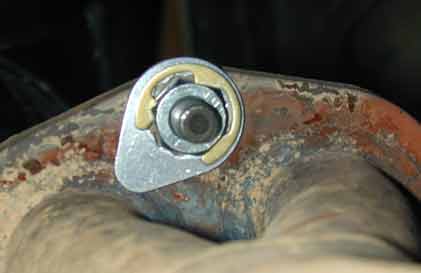
A quick check revealed that one of the nut on the down pipe is too far from any vertical surface, The reach of the locking tap would not be long enough.
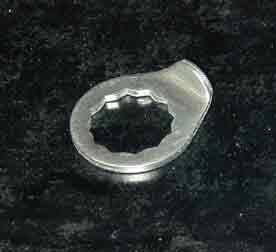
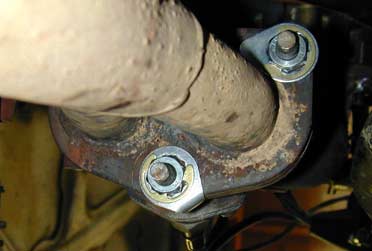
Use two adjustable wrench, I bent a section of the tab 90deg up to lock over the outside of the down pipe flange. Be careful not to to make the bend too sharp, or it can break.
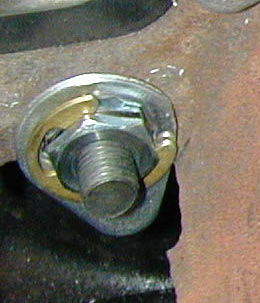
For the stock exhaust manifold, the right side of the two lower center nuts was too close to the wall of the manifold, and need to be clearanced. I split the difference by cutting some on the manifold, and some on the locking tab.
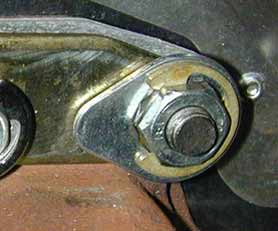
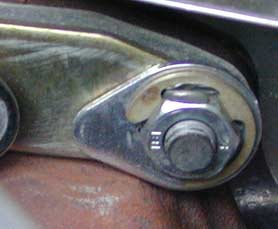
During the installation of one of the nut, I left too much of an angle between the locking tap and the surface of the manifold. See above left. After a 15 minute drive, I found that the nut had visibly loosened due to vibration on the right picture. The tab shows a definite rotation in the nut. This shows how strong the loosening force is on the exhaust manifold. It is no wonder that even locking nuts loosen over time.
After installation, I drove the truck for 15 minutes to allowed the exhaust gasket to take a set. After the initial set, I tightened all the nuts to the 33 ft-lbs of torque again. The upper ones required an extra 1/4 of a turn, while the 2 lower center ones were tight. After the final tightening, afew nuts were in between engagement points on the locking tab. I tighten the nut some until it almost lined up with the next set of teeth, then ground away at the locking tap to make up the difference. Since the stud is bolted onto the aluminum cylinder head, make sure you are not too ambitious in tightening the nuts. I found out the hard way that there is not too much strength margin on the stud of the 22RE cylinder head. Yes they pull out if you over tighten them even relatively small amount. While on the subject on tightening torque, you may be tempted to put antiseize compound on the nut since now they are locked with tabs. A word of caution is that the antiseize compound can make the threads quite slippery, and increase the tension on the stud. I did a test at work tensioning a nut with and without antiseize compound while monitoring the tension with a load gauge. The difference was as much as 20%. That will be enough to cause the stud to pull out.

Above shows the finished installation of Stage 8 locking nuts. Looks pretty trick. The best thing was that the truck ran smoother than it ever had. No more hessitation at idle as if the engine was going to die, then catches on again. The idle is now perfectly smooth so that you could hardly feel it. Exhaust sounded much better too. Previously, at 3000-4000rpm, the exhaust was very noisy. It felt like a combination of something stuffed up inside, and having something loose in the exhaust system. Now the engine rev. up smoothly all through the rpm range. Just the smoothness made the car feel more powerful. The power most likely improved without the exhaust leak. The gas mileage went from 19mpg to 20mpg. The best thing is that I don't ever have to worry about the exhaust bolts again for the life of the car. For that, it was worth the $33.05 for cheap insurance.
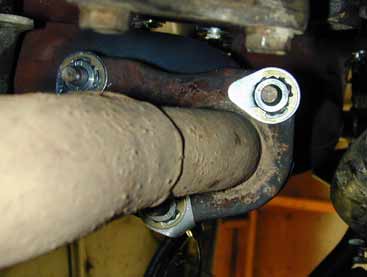
Stage 8 nuts installed on the downpipe.
Update 6 months 10k miles latter:
Manifold nuts were holding up fine. However, two of the 3 downpip nuts were loose. It was due to crushing of the gasket between the flange rather than the Stage8 fasteners not working. Lesson learned here is that the nuts on the down pipe needs to be tightened ever 1k miles for the first several thousand miles until the gasket is fully seated. This could also have been because the mating flanges on my exhausts were warped.